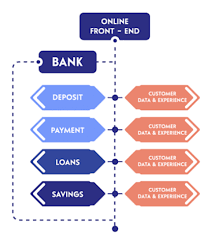The evolution of core banking systems has had a profound impact on banking operations, revolutionizing the way banks manage their processes, serve customers, and adapt to market changes. Here is a detailed exploration of the evolution and impact of core banking systems:
- Legacy Mainframe Systems: The early core banking systems were based on mainframe technology, characterized by centralized processing and limited functionality. These systems were primarily focused on transaction processing and basic account management. However, they lacked flexibility, scalability, and integration capabilities, making it challenging for banks to introduce new products, adapt to changing customer needs, and respond to market demands.
- Modular Core Banking Systems: With technological advancements, banks started adopting modular core banking systems. These systems were designed with a modular architecture, allowing banks to replace or upgrade specific modules without disrupting the entire system. This modular approach increased flexibility, enabling banks to introduce new services, customize functionalities, and integrate with third-party systems more easily. It also facilitated the development of multi-channel banking, where customers could access their accounts through various channels like branches, ATMs, online banking, and mobile banking.
- Digital Transformation and Channel Expansion: The rise of the internet and digital technologies led to a significant shift in core banking systems. Banks embraced online banking and expanded their services to include mobile banking, enabling customers to perform transactions and access account information through digital channels. Core banking systems became the foundation for seamless integration across multiple channels, providing customers with a unified experience. This expansion into digital channels increased convenience, accessibility, and 24/7 banking capabilities for customers.
- Customer-Centricity and Relationship Management: Core banking systems began focusing on customer-centricity and enhancing customer relationships. They evolved to capture and store comprehensive customer data, including transaction history, preferences, and behavior. This enabled banks to gain insights into customer needs, personalize services, and offer targeted products and marketing campaigns. Core banking systems facilitated improved customer relationship management, enabling banks to build stronger customer loyalty and satisfaction.
- Automation and Process Efficiency: Core banking systems played a crucial role in automating and streamlining banking operations. Manual processes were replaced with automated workflows, reducing human errors and enhancing operational efficiency. Core banking systems automated tasks such as account opening, transaction processing, loan origination, and payment processing, leading to faster turnaround times, reduced costs, and improved productivity. Automated workflows also ensured greater accuracy and compliance with regulatory requirements.
- Risk Management and Compliance: Core banking systems evolved to incorporate robust risk management and compliance features. They integrated functionalities for Know Your Customer (KYC), Anti-Money Laundering (AML), and fraud detection. These systems facilitated real-time monitoring, risk assessment, and compliance reporting, helping banks mitigate risks and meet regulatory obligations. Core banking systems became instrumental in ensuring data security, safeguarding customer information, and maintaining regulatory compliance.
- Real-Time Processing and Analytics: Core banking systems advanced to support real-time processing and analytics capabilities. Banks could process transactions and update account information in real-time, enabling customers to access up-to-date information instantly. Real-time data also empowered banks to leverage analytics, gaining insights into customer behavior, market trends, and business performance. Data analytics facilitated data-driven decision-making, enabling banks to make informed strategic choices, develop targeted products, and enhance customer experiences.
- Open Banking and API Integration: The emergence of open banking and the demand for collaboration with third-party providers led to the integration of open APIs within core banking systems. Open APIs allowed secure data sharing and seamless integration with external systems and fintech partners. This facilitated the development of innovative services, expanded product offerings, and enhanced customer experiences through partnerships. Core banking systems became the gateway for banks to participate in the open banking ecosystem.
Overall, the evolution of core banking systems has transformed banking operations by increasing flexibility, efficiency, customer-centricity, risk management, and compliance. These systems have enabled banks to embrace digital transformation, provide personalized services, improve operational efficiency, and adapt to the ever-changing banking landscape. Core banking systems are critical for banks to remain competitive, meet customer expectations, and drive innovation in the financial industry.
